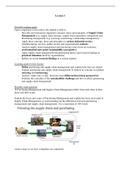Lecture 1
Overall Learning goals:
Upon completion of the course, the student is able to:
- Describe and summarize important concepts, ideas and principles of Supply Chain
Management (e.g. supply chain strategy, supply chain operations, integration) and
Purchasing management (e.g. sourcing, outsourcing, relationship management).
- Apply these concepts, ideas and principles in various industrial sectors
(manufacturing, services, public sector) and organizational contexts.
- Analyze supply chain management and purchasing issues from an economic,
environmental and social (sustainability) perspective.
- Apply supply chain management and purchasing theory and research findings to
practical situations faced by organizations.
- Reflect on recent research findings in a critical manner.
Learning goals for this lecture
- Define purchasing and supply chain management and explain how they are related
- Explain purchasing and supply chain management in relation to concepts as (global)
sourcing and outsourcing
- Analyse ‘make, buy or ally’ decisions from different theoretical perspectives
- Evaluate the criticality of the sustainability challenge and how it affects purchasing
and supply chain management
Possible exam question
à Purchasing Management and Supply Chain Management differ from each other in their
focus and their scope.
Explain the focus and scope of Purchasing Management and explain the focus and scope of
Supply Chain Management, as such pointing out the differences between purchasing
management and supply chain management. Use a maximum of 100 words.
create a map: to see how companies are connected
,example:
Toyota
- focus: kind of direction I am moving
o who is before our car manufacturer or who is after
o we refer to this two-direction
o clarify: upstream, down-steam or both
- scope
o only direct actors or not
- purchasing
o only considering the direct supplier
- supply
o not only the upstream, but also the downstream
o scope is much wider
o start from supplier raw material
o downstream: next actor = distributor à consumer
Definition if Purchasing Management
- management of firm’s external sources
- ensuring the supply of goods, services, knowledge, capabilities
- to perform the firm’s primary and support activities
Purchasing today: trends (p 3-5)
- from administrative to strategic function
- from buying materials/parts to buying competence
- from cost focus to performance focus (include sustainability suspect)
Definition of SC
- the management of upstream and downstream relations with supplies and customers to
deliver superior customer values at less cost to SC as a whole
- optimal situ. for your company – maybe this choice is incremental to your suppliers
- what the final customer wants – how the different actors of your chain contribute to
this?
One main perspective what we use, according to the book:
à UNIONIST: purchasing is a subaspect of SCM
BUT: different focus, scope and performance aims
,What is at the basis of PSCM?
- outsourcing
o when you contract functions activities outside the organization
o suppliers that are good at producing that specific service
o local or international level
o what am I going to make in-house?
o what am I going to deliver?
o what a company prefers? (Chapter5)
§ related to cost
§ access to good-quality suppliers
§ gain access to markets/circumvent trade barriers
§ scarce resources
o Why outsource? (chapter 5)
§ Decrease production costs
§ Access to good-quality suppliers
§ Gain access to markets / circumvent trade barriers
§ Gain access to scarce resources
§ Etc.
o when to outsource?
§ make or buy? – 2 underlying theorydeciding when to outsource
1. TCT: Transaction Cost Theory
• have to minimize the cost
• consider different aspects
o asset specificity = refer to the investments you need to
do to have that product/component/service
§ is a specific knowledge needed?
o opportunistic behavior = what are the costs of reducing
uncertainty?
• HIGH: make it for yourself
• LOW: buy
• HYBRID FORMS: long term contracting (collaborations),
alliances
• example: electronic industry
o high asset specificity, medium to high uncertainty
o MAKE OR BUY?
§ 2 medium to long term relationship, 1 sort term
relationship
§ theory gives us guidelines, in reality is more
complicated, think is a critical way
2. (RBV) Resource Based View
• sources can provide sustained a competitive advantage
o sustained: long term advantage
o like: skills, resources, activities
• core competencies
o characteristics
1) Valuable: to have opportunities in the market
2) Rare: cannot be acquired from many companies
3) Initiable: you need long term training
4) Non-substitutable:
, § example: oil or butter
o core: keep in house
o deliver customer value
o differentiate firm from competitors
o can potentially be extended and developed
• example: Coca Cola
What to keep in-house?
o core competencies: (table to insert from slide)
o exam question
o Synthesis of TCE and RBV:
§ recommendation in outsourcing decisions
o Outsourcing and PSCM:
§ outsourcing decision
• contracting out activities/functions to specialized suppliers
§ leads to purchasing activities
• who will provide activity/function demanded?
§ and to management of chain and networks
• How to make sure all work together to deliver…
o Some outsourcing-related challenges
1. Management of purchasing activities
§ Supplier selection
§ Negotiating terms and conditions
§ Supplier monitoring
2. Management of chains and networks
§ Increasing supply chain length: what do 2nd, 3rd etc tier suppliers do?
§ Quality assurance and product reliability
§ Environmental and ethical considerations
Sustainability
= using resourcing to meet the needs of the present without compromising the ability of
future generations to meet their own needs
à Clear enough?
- What resources will future generations require?
- At what level can we pollute without negatively influencing future generations?
- To what extent will new sources of resources be identified?
- To what extent can (future) technological developments offset negative consequences?







